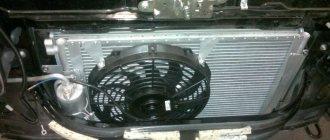Forced activation of the VAZ 2112 fan 16 valves where it is located
The engine gets very hot?
Forced fan activation on VAZ 2110 2111 2112 vehicles Probably, many have noticed that the fan activation temperature on the latest generation VAZ 2110 -2112 engines (100-105 C) is too high compared to the normal operating temperature of the engine (85-90 C). First of all, this introduction is connected with the manufacturer’s struggle for cleaner exhaust from the pipe of your car (requirements of modern Euro 3 standards and higher). At this temperature, more complete combustion of the fuel and its components occurs.
But it should be noted that, as always, a given positive side for one aspect brings something negative for another. So, with a slight, but still overheating of the engine and head, irreversible physicochemical processes occur in the metal, which ultimately affects the overall final operation of the engine hours of the power unit. Apart from the fact that in the event of a failure of the electrical components that affect the fan’s activation, the time to notice this at an elevated standard switching temperature of 105 C to overheating of 125 C will be significantly less than from normal operating temperature to overheating.
For more uniform and controlled operation of the engine, it is proposed to make a parallel fan circuit. A positive contact is always connected to one of the fan contacts, and for the second negative contact it is suggested to connect through a parallel wire with a switch according to Fig. 1.
Figure 1 Electrical circuit diagram for connecting the radiator fan VAZ 2110 2111 2112
The following is a photo of the contact in the engine compartment and an option for installing a power button.
Figure 2 Wire connection location in the engine compartment to turn on the VAZ 21102 radiator fan
Figure 3 Alternative location for installing the radiator fan switch VAZ 2110 2111 2112
After implementing this solution, all that remains is to mention the additional opportunities to control the operating temperature of the power unit with all the subsequent positive arguments given above.
Source
How to change the temperature?
Over time, more and more complaints appear about the operation of the cooling fan activation system. The most important design flaw is the lack of several fan operating modes and the abrupt start of its motor . Indeed, in the summer heat the fan has to work at full strength, and this is understandable. However, most often the fan produces excessive performance, which leads to rapid cooling and frequent starts.
This leads to a current overload on the on-board network.
In addition, the starting temperature threshold is too high, so the engine often overheats . Unfortunately, you can only change the fan startup parameters by reflashing the electronic control unit or upgrading the electric motor activation system. Reflashing the ECU is carried out by a competent specialist, and it is possible to set any desired temperature for turning the fan on and off.
Basic methods
Diagram for connecting an additional fan sensor.
There are also several solutions to changing the operating modes of the fan motor. The simplest of them is to install an additional switching sensor from carburetor engines (in the diagram above). It is configured to turn on at a temperature of 97-100 ° C , which will be quite enough. And in order for the fan to operate in this mode at half power, a resistance from the VAZ heater is installed in the circuit.
Sensor. Tee "Gazelle". Additional resistor from UAZ.
Thus, the upgraded fan will have several advantages:
- The fan switch-on temperature is below standard.
- Two operating modes - ½ and full power.
- Less noisy fan operation.
- Less starting load on the on-board network.
- More flexible temperature regime of engine operation.
- The normal mode of turning on the fan is maintained.
Inserting a tee into the section of the upper pipe. Installing a resistor on the fan housing.
In this way, it is possible to modify the control system for the electric cooling radiator fan of the VAZ-2110. Stable temperatures to everyone and good roads!
Cooling system
Typically, the cooling system of any car consists of the following elements:
- radiator;
- BC cooling jacket;
- thermostat;
- connecting pipes and hoses;
- centrifugal pump;
- fan with electric motor.
And if some device malfunctions, then on a VAZ-2110 with an injector the cooling fan does not turn on.
View gallery
Every element is necessary for the proper operation of the entire system, but the fan is still one of the important components. Its task is to cool the radiator and, accordingly, the liquid passing through it, when necessary. If it stops turning on, this affects the performance of the entire system.
Operating mode
On VAZ-2112 cars, the operating temperature of the engine is about 89 degrees, the thermostat begins to open at 85, and the fan, with standard settings, starts at 105 and turns off at 97. We talked in more detail about the cooling system diagram of the VAZ-2112 in this material: complete diagram of the cooling system of the VAZ-2112.
Causes of malfunction
If the radiator fan refuses to start, check the items in the following order:
- Fuse - Check this fuse element for continuity in the fuse block. It is located there under the number F7 and has a rating of 20 amperes.
Fan fuse - yellow F7. (editing machine mounting block, 124 engine)
The relay is located under the number “4”.
The sensor should be checked and replaced if necessary.
You can try to repair the electric motor.
When all of the above methods did not bring the desired result, you need to look for the reason only in the wiring, “ringing” them one by one. Perhaps there was a break or break in the wire somewhere.
How to check wiring
Finding a broken conductor in a car's electrical circuit yourself is not at all difficult. It is necessary to check (ring) all wires in the indicated areas with a tester.
For carburetor engines:
- from the switch on sensor to the fan;
- from the fan to the mounting block (fuse);
- from the mounting block to the relay.
For injection engines:
- from the main relay to the fan switch relay;
- from the switching relay to the fan and controller;
- from temperature sensor to controller;
- from the fan to the mounting block (fuse).
If a wiring break is detected, it must be restored, as well as the possible cause of the circuit break must be identified and eliminated.
Sensor
The Internet today can bring significant help. On some forums you can find owners asking why the VAZ-2110 cooling fan with an injector does not turn on. The reasons and photos are discussed by several people, who mainly refer to the sensor.
View gallery
To check it, start the engine and wait until the coolant warms up to operating temperature. After this, you need to disconnect the sensor connector, the controller will detect an open circuit and switch the fan operation to emergency mode. If it works, then the reason lies in the sensor. It is worth replacing it and checking it again to be sure.
Thermostat
Many modern cars are equipped with thermostats with sensors. This allows you to more efficiently manage the cooling system. But such management has its drawbacks. In particular, when the system breaks down, various “miracles” can begin. If the sensor installed on the thermostat fails, the fan will run constantly. The reason for this is the following. The control unit, not receiving signals about the operation of the thermostat, goes into emergency mode. At the same time, just in case, the fan turns on; in case of such an error, it will work constantly.
Checking the sensor is quite simple. Like any temperature sensor, in normal condition, it should show infinite resistance when the engine is cold, in all other cases it should show from 100 to 500 ohms. If the check shows different readings, it is better to replace the sensor. Fortunately, it is quite inexpensive.
Air temperature sensor
. Some modern cars are equipped with additional oncoming flow temperature sensors. That is, they react to the ambient temperature. If the indicator specified in them is exceeded, they give a command to turn on the fan. This is done to increase the cooling efficiency of the motor.
This scheme is often found on foreign cars that have sandwich radiators consisting of 3 layers. In this case, the fan will work almost all summer even on a cold motor. It is not recommended to disconnect the sensor; this may lead to engine overheating.
Why the Fan Doesn't Work on 2112
The fan does not work cooling the VAZ-2110 . Cooling fan circuit diagram
Precise operation of the cooling system is necessary to ensure safe and stable thermal conditions of the internal combustion engine. The slightest failure will lead to overheating of the engine, which can lead to burnout of the head gasket or failure of the piston group elements.
The radiator fan is one of the key components of a car's cooling system. Its role is to quickly cool the liquid in the radiator. Problems turning it on. a common occurrence for our cars.
In this article we will talk about possible reasons why the cooling fan does not work in the VAZ-2110, and also consider options for removing them. But first, let's look at its design and working principle.
What is a radiator fan
Structurally, fan consists of:
- frame (frame);
- drive (electric motor);
- Impellers.
The shaft-mounted impeller motor is mounted inside a rectangular metal frame that secures it to the rear of the radiator. When voltage (12V) is applied to the actuator contacts, it begins to work, rotating the blades and creating a directed air flow that actually cools the antifreeze or antifreeze.
What should the engine operating temperature be?
Engine operating temperature shown on the instrument panel
If we take the information from the international convention of automobile manufacturers dated December 1, 1992, then the unified standard for engine operating temperature is considered to be 90 degrees Celsius . With such indicators, the engine operates as efficiently as possible and does not create residual negative effects.
When switching to more advanced engine manufacturing technologies in 2004, it was accepted that a specific indicator of this indicator cannot be held in one position, and therefore they made a gradation of acceptable standards, which amounted to 85-105 degrees Celsius.
Engine overheating shown on the instrument panel
According to data from the manufacturer AvtoVAZ, on a 16-valve VAZ-2112 engine, the operating temperature of the engine is considered to be 87-103 degrees Celsius.
At this temperature, all systems function normally, and the motor is not subject to negative factors and consequences.
Read more: What is vehicle type approval
Cooling system design
The engine cooling system has many components that are interconnected, and if one fails, the entire system will not be able to function. So, let's look at the location diagram and decoding of the indicators for the cooling system of a 16-valve engine.
Diagram of the cooling system operation
1 – heater radiator; 2 – steam removal hose of the heater radiator; 3 – outlet hose; 4 – supply hose; 5 – coolant temperature sensor (in the block head); 6 – pump supply pipe hose; 7 – thermostat; 8 – filling hose; 9 – expansion tank plug; 10 – coolant level indicator sensor; 11 – expansion tank; 12 – exhaust pipe; 13 – liquid chamber of the carburetor starting device; 14 – radiator outlet hose; 15 – radiator supply hose; 16 – radiator steam outlet hose; 17 – left radiator tank; 18 – sensor for turning on the electric fan; 19 – fan electric motor; 20 – electric fan impeller; 21 – right radiator tank; 22 – drain plug; 23 – electric fan casing; 24 – timing belt; 25 – coolant pump impeller; 26 – supply pipe of the coolant pump; 27 – coolant supply hose to the throttle pipe; 28 – coolant drain hose from the throttle pipe; 29 – coolant temperature sensor in the outlet pipe; 30 – radiator tubes; 31 – radiator core.
Main malfunctions and ways to solve them
In fact, there are quite a lot of components in the cooling system that are susceptible to failure. This depends not only on the service life, but also on maintenance, as well as the quality of the parts. So, let's look at the main components, faults and methods for solving them.
Cooling radiator
Cooling radiator pulled from the engine
As practice shows, this part lasts quite a long time. The main cause of failure is clogged internal channels. So, if the blockage is sufficiently dense, the engine begins to heat up, the high pressure created by the pump can lead to a rupture of the tube and the radiator will leak.
Some car enthusiasts have it soldered and cleaned, but as practice shows, after a short period of time, a leak forms again. Therefore, if this part fails, it must be replaced with a new one.
Heater radiator
Heater radiator assembly with fan
The only detail in the system that does not affect the overall picture. The heater radiator ensures heating of the interior temperature and therefore its use is seasonal. Malfunctions and methods for solving them are the same as with the main radiator.
Pipes
KIT kit of cooling system pipes
One of the main components of the cooling system, since it is through the pipes that the fluid circulates through the system.
The main malfunction is considered to be wear, namely the appearance of cracks and leaks of coolant. To fix the problem, you need to replace the damaged element.
Of course, it is recommended to change everything in sets, since it is unknown how many kilometers later another one will have to be replaced, and the process itself requires draining the coolant.
Read more: What can you drink while driving?
Water pump
Water pump removed from the car
The pump circulates coolant throughout the system. So, if a leak occurs from the water pump bearing or noise increases, these are the first signs that the part needs to be replaced.
Thermostat
Thermostat disassembly process
The thermostat is the part of the cooling system that is most often replaced.
Thus, the first signs of a unit malfunction are considered to be an increase in the operating temperature of the engine to the maximum, as well as frequent turning on of the cooling fan. To fix the problem, you need to replace it with a new product.
Radiator cooling fan
Electric fan with casing removed
How to prepare for the event
If you need to repair a VAZ stove fan, you need to make sure you have the necessary tools:
- head 10 millimeters, deep;
- Phillips screwdriver (2 varieties: regular and short);
- ratchet with extension.
Only if all the tools are available can the main activities be carried out. Of course, for a successful result, at least minimal experience with wrenches and screwdrivers is required. If there is no relevant experience, the task at hand becomes significantly more difficult.
Replacing an electric fan in a car
- We park the car on a flat surface and immobilize it with the parking brake.
- Open the hood and disconnect the negative terminal.
- Using a 10mm wrench, unscrew the fastenings of the air filter housing.
- Using a screwdriver, loosen the air duct clamp on the air flow sensor and remove the corrugation.
- We unscrew the screws securing the cover of the air filter housing and remove the filter element.
- Using a size 8 wrench, unscrew the air intake mount and remove it.
- Using a 10mm wrench, then an 8mm wrench, unscrew the nuts securing the fan casing around the perimeter (6 pieces in total).
- Disconnect the wire block on the fan connector.
- Carefully remove the fan casing along with the drive.
- Using a 10mm wrench, unscrew the 3 bolts holding the electric motor to the casing.
- We put a new one in its place.
- We install the structure in place, fix it, and connect the connector.
- We carry out further installation in the reverse order.
Reasons why the fan may not turn on
Considering the described switching process, the reasons for the fan not working may be:
- faulty temperature sensor;
- faulty relay;
- blown fuse;
- electrical circuit break;
- Problems with the electric fan drive.
In addition, the expansion tank cap can also affect the timely activation of the fan. If it is faulty and its valve is not able to maintain pressure above atmospheric, the water, which is part of the coolant, will definitely boil at 1000C, and the sensor set to a higher temperature will not have time to operate.
Safety valve
Knowing physics, you will agree that at normal atmospheric pressure, the water that is part of antifreeze boils at a temperature of 100 degrees Celsius.
If the VAZ 2110 cooling fan fuse, that is, the valve located on the expansion tank cap, turns out to be faulty, and there is atmospheric pressure inside it, the cooling liquid will boil, but the fan will not be able to start working even with a working electrical circuit. This is because the fan switching sensor on the injection VAZ 2110 has a switching temperature of more than 100 degrees Celsius.
To fix this problem, replace the expansion tank cap. The new element must maintain the pressure inside the system above atmospheric pressure, which will allow the laws of physics to work, the boiling temperature to rise to 105 degrees Celsius and thereby turn on the blades of the unit.
Design
The cooling system includes many components. Among those that interest us today, which can cause problems with the radiator fan, we note:
- Electric fan. This unit starts working when the coolant temperature reaches 100-105 degrees Celsius;
- Fan switch sensor. It is configured to operate precisely within the specified temperature range. The sensor is located on the inlet pipe of the cylinder block (labeling from the sensor factory is LS0112);
- Fuse marked F7. It is located in the mounting block;
- Fan relay. You will find this unit already in the cabin, under the right panel of the front console.
If the radiator fan does not work on your VAZ 2110, the cause of the malfunction should be looked for in the above-mentioned system elements. Although there may be one situation in which the electrical circuit has nothing to do with the fault.
Operation of the cooling fan in fuel-injected cars
The operation of the fan unit for cooling the temperature in injection engines is assigned to an electronic motor controller. Its software is configured to trigger the engine overheat protection system in the temperature range from 100 to 105 degrees Celsius. If a defect occurs in the operation of the fan switch on in a VAZ with an injector, the controller “remembers” the error code and the fan starts working when the motor is turned on.
However, there are separate precedents when electronics in the form of a controller “reads” a defect and the fan installation may not begin to function when extreme temperature values are reached, i.e. above 105 degrees Celsius. Then, to test the circuit and the device, you need to disconnect the contact of the cooling fan switch sensor with the engine turned on.
If the circuit is functioning, then the fan unit should turn on and turn off with reverse action. If the circuit does not function, a test should be carried out to determine the suitability of the safety device and the technical readiness of the wiring and relay.
A quick check of the system is carried out as follows: we bridge the two contacts of the fan relay. If the product works in this position, then, without disconnecting the relay from the wire block, bridge the body of the relay and its contact using a “control”. In this position, the relay should function like the fan unit, which means that the controller or the relay connecting wire to the contact of this device is faulty.
If there is no sound of relay initiation, there is only one conclusion - the part requires replacement. If the fan unit does not start working when the relay terminals are closed, it is necessary to test the fuse for integrity and the power supply to the terminals of the fan unit. If power is supplied to one contact and not to the other, this may indicate defects in the EDC of the fan installation.
Fuse, motor and relay
You should look for the cause of overheating, starting with checking the fuse and fan relay. The first of them is located in the mounting block of the engine compartment. There it is labeled F7 (20A). You need to take it out and visually assess its integrity or use a multimeter.
In most cases, the cooling fan of the VAZ-2110 (injector, 8 valves) does not turn on precisely because of the fuse, since the control signal does not pass through. It is worth taking it out and visually assessing its integrity or using a multimeter. If necessary, replace it immediately; otherwise, you should look for the cause elsewhere. And in the meantime, it’s worth checking the fan itself. To do this, disconnect the fan connector and connect the electric motor directly to the battery through the wires, not forgetting the polarity.
View gallery
If the drive is in order, then you should head to the interior, since this is where the relay is located. Its more accurate location is another mounting block on the left side relative to the front passenger’s feet. Of the three relays, the one on the left is the one you need. To perform the test, you need to install another relay in place of the old one. After this, start the car and wait for it to heat up to maximum temperature, while simultaneously watching the fan. If there is no result, the search continues.
Procedure. Step-by-step instruction
If after completing the next step the problem goes away, further checks are stopped.
- Open the hood.
- Wait for the engine to cool down.
- Perform an initial visual inspection: integrity of the hoses, reliability of the clamps, absence of leaks or cracks.
- Make sure that the expander cover elements are in good condition. Remove scale, rust, clear holes, wipe, assemble. The absence of noticeable damage to parts gives hope that the product will work.
The valve design is elementary. The cover contains a spring. Functionally, it is designed to regulate the pressure in the cooling circuit. A hot engine increases it, a cold engine decreases it.
Compressing at a value of 1.1 atmospheres, the spring relieves excess pressure and prevents the destruction of hoses and the tank. As the motor cools, it creates a vacuum effect. The tank will begin to flatten. The valve equalizes the pressure.
The lid screws tightly on the thread, eliminating distortions. There should be a gap between it and the body. An overtightened valve will not work. It is difficult to test the device's operation in road conditions. You can check by replacing it with a known good one.
Inspect the electrical wiring elements to ensure a reliable connection
Possible factors for damage to electrical circuits:
- vibration;
- oxidation;
- burning;
- breakage, fraying of electrical wires;
- insulation aging, short circuit.
Switch the tester to resistance measurement mode. Remove it with special tweezers and ring the fuse link F7 located in the mounting block.
Replace the burnt-out element with a serviceable one with a rating of 20A. Inspect and clean the nest. Insert fuse.
It was not possible to find out the reason, the protection triggered again - look for a short circuit.
Disconnect the fan plug. Use a tester to measure the circuit of the electric motor windings. Zero resistance or a break indicate the need to replace the radiator blower electric drive.
Interturn short circuits that cause multiple replacements of fuse links cannot be measured with the device.
Sensor check
Start the car. Pull out the coolant temperature sensor connector. The fan starts working - the sensor needs to be replaced. Secure the disconnected wire. Drive to a nearby service station.
Relay test
There is a hatch on the floor at the front passenger's feet.
Below it is a built-in panel with three relays of the same type:
- fan installation;
- fuel pump;
- ignition (main thing).
By replacing each other, try to start the airflow. The VAZ 2110 fan does not work - go to the next step.
Where is the VAZ 2110 cooling fan relay located?
If you are wondering where the fan relay is located on a VAZ 2110, then this photo below will answer your question and you can easily find where the cooling fan relay is located on a VAZ 2110.
Check the electric motor
Winding measurements did not reveal a malfunction. Apply voltage briefly from the battery using additional insulated conductors. The operation of the fan indicates a malfunction of the controller, which does not output a signal to the relay.
- The only correct solution is to turn on the airflow directly and urgently visit a service station.
- Prevention of breakdowns of the cooling system of the VAZ 2110 injector 16 valves.
- Periodically inspect the components of the cooling system.
- Monitor the cooling temperature on the device, listen to the operation of the fan.
- Maintain coolant level. Replace after 2 years or 30,000 km.
- Use the solution to remove rust and scale.
- Signs of a change in the properties of the coolant are a change in color, an increase in fluidity.
- Check the density with a hydrometer.
- Do not mix coolants.
- Every twelve months, rinse the expansion tank cap with water and check it on a stand with a pressure gauge.
- Avoid contact of aggressive liquids with electrical wiring and electric motor windings.
Improvements to the fan start control circuit for the VAZ 2110 injector
The smooth functioning of the engine worries factory designers, auto mechanics, and car enthusiasts. Folk craftsmen change the design of valves and electrical circuits.
Installation of three position toggle switch:
- continuously on: the VAZ 2110 cooling fan does not work;
- constantly switched off: warming up the engine when starting in the cold season, automatic control is faulty;
- automatic mode: controlled by the controller, the equipment is working properly, the algorithm is executed correctly.
When choosing an installation location, consider the following conditions:
- prevent accidental switching;
- not to be confused with other controls.
It is important to remember when modifying the design about the safety of the changes made.
Problems with the electrical circuit
If checking the reservoir cap does not reveal any faults, then the problem may lie in the circuit.
The search should begin by checking the serviceability of fuse F7. To do this, you need to gain access to the mounting block and check the contacts for the presence of oxidative traces. If nothing of the sort was noted, then proceed to the next step. Otherwise, clean the contact connections or simply replace the fuse with a new element. The part is inexpensive.
The next step is to check the fan switch sensor:
- Initially, warm up the car to 100 degrees.
- Turn off the engine and immediately start the engine.
- Open the hood and disconnect the terminal from the fan sensor.
- If, after disconnecting the contact, the fan starts working, then the unit is operational, but the sensor needs to be replaced.
- When the fan does not turn on after disconnecting the terminal, then the situation is the opposite - the sensor is working, but the fan is not.
Electric motor breakdowns are often the reason why the fan does not turn on. If all the previous measures did not help you find the problem, then you will need to dismantle the electric motor. The following problems can be identified in this node:
- The commutator brushes are worn.
- The brushes are stuck.
- There was a short circuit in the armature winding - the problem is identified by a characteristic smell.
Problems with the relay. Sometimes a situation arises when the cooling system fan start button simply fails. In this case, you will need to carry out the following work:
- Remove the trim on the right side of the dashboard inside the passenger compartment. To do this, you need to unscrew two screws.
- Under this panel there are three relays.
- The required relay is usually located on the side in relation to the front of the car.
- To be sure to act correctly, find the car's operating manual and check the wires that go to the relay we need.
- To solve the problem with the relay, you just need to install a new element. You should not skimp on this component. Cheap models break down very quickly.
Possible causes of malfunction
Before carrying out repairs, you should carefully study the possible causes of a malfunction of the car heater fan:
- Burnt fuse. The real reason is the most banal and simple, but at the same time it is the one that leads to the greatest problems in solving the existing issue. Replacing a fuse turns out to be a very simple procedure that any motorist can successfully handle. Despite simple repairs, it is extremely difficult to detect the short circuit that led to the blown fuse.
- Oxidation of contacts that should be used to establish the operation of a car heater.
- The ignition relay does not allow the heater to turn on and start working successfully.
- An additional resistor can result in only the third speed being operational.
- A faulty car interior heating switch requires replacing the fuse.
- A non-working electric fan motor is another important reason. In this case, it is necessary to replace the heater motor or at least check its contact with the vehicle. In most cases, the cause is hidden in a burnt-out electric motor, poor contact with the machine, or sticking electric motor brushes.
Connection schemes
In VAZ 2110 injection and carburetor engines, the TM-108 bimetallic temperature sensor is used in different ways to control turning the fan motor on and off.
For carburetor engines it is located on the radiator on the left in the direction of travel. When the threaded part located directly in the coolant is heated, the bimetallic plate bends and closes the contacts. The voltage from the battery is supplied through a fuse to one contact of the electric motor, the second, when the sensor is triggered, is connected to the housing, setting the impeller in motion.
Fan switching sensor (carburetor VAZ 2110)
For VAZ 2110 and TM-108 injectors, it is located near the thermostat, the signal is sent to the electronic control unit (ECU). The control signal from the ECU is sent to the cooling system fan relay, which, similar to the sensor of a carburetor engine, controls the electric motor.
Injection fan switch sensor
All engines have another device in the cylinder block, the signal of which is used to indicate the coolant temperature on the panel in the cabin.
Constantly running fan
In some situations, the cooling fan may run continuously, regardless of whether the engine is cold or hot. In this case, there may be various reasons, corresponding methods for checking the malfunction, as well as ways to solve the breakdown.
| Causes | Diagnostics | How to fix the problem |
| Open circuit in the coolant temperature sensor or its circuits | The “Check engine” lamp is on. The sensor and circuits need to be checked with an ohmmeter | Replace sensor |
| The electric fan relay contacts do not open | Check with a multimeter | Replace relay |
| The injection system control unit or its circuit (ECU) is faulty | Check the unit at a specialized car service center | Replace the ECU firmware or the unit itself |
| (Carburetor) Radiator thermal switch contacts do not open | Disconnect the terminals from the thermal switch terminals. After this, the electric fan will stop working. | Replace thermal switch |
Alas, sometimes even after such thorough and detailed checks, the cooling system fan on the VAZ 2110 still does not turn on. In this case, the car owner has no choice but to contact a service station.
Injection sensor for turning on the blower device. Proven and reliable car services will be able to conduct full computer diagnostics of the cooling system and determine the reasons for the non-working cooling fan. The problem may be much larger than a blown fuse.
Don't be afraid to turn to specialists, even if you consider yourself an experienced auto mechanic who has always solved your car's problems on your own. Modern equipment, a professional approach, computerization of car services - all this allows you to quickly determine the causes of malfunctions, which, according to your old-fashioned method, would have taken several days. Auto repair shops also have their advantages.
Electrical circuit malfunctions
If everything is fine with the tank cap and there are no problems with pressure, then the causes of the radiator cooling malfunction should be sought in its electrical circuit.
- The search begins with checking the functionality of the fuse marked F7. To do this, you have to get to the mounting block. Check the quality of the contacts and the presence of traces of oxidation. If everything is good here, we move on. If the contacts are broken, simply clean them, or simply change the fuse. This is a small financial cost.
- The next place to check will be the VAZ 2110 fan switch sensor. You do not have to go to a specialized service station to check the efficiency of the sensor. This is done in a garage: Warm up the engine of your car to above 100 degrees Celsius;
- Turn off the engine, then start the engine again;
- Lift the hood and remove the terminal from the VAZ 2110 fan sensor;
- If after removing the element the fan begins to spin, then the unit is working properly, but there are problems with the sensor;
- When on a VAZ 2110 the cooling system fan does not turn on after disconnecting the terminal, the situation is the opposite - the fan does not work, but the sensor is in good condition.
- Electric motor. It is possible that the radiator fan stopped working precisely because of a faulty electric motor. If all previous manipulations did not produce results, you will have to remove the electric motor. It may have several characteristic failures:
- The commutator brushes are worn out;
- The commutator brushes are stuck;
- A short circuit has occurred in the armature winding (this can be determined by the characteristic unpleasant odor).
- Relay. Maybe the button to turn on the cooling radiator fan on your VAZ 2110 has simply failed. In such a situation:
- The trim on the right side of the console inside the cabin is removed by unscrewing two screws;
- There are three relays under the panel;
- The relay we are looking for is usually located on the edge of the row in relation to the front of the car;
- To play it safe, arm yourself with the instruction manual and check the wiring that goes to our turn-on relay;
- To resolve the problem, install a new, functioning and good quality relay.
Possible malfunctions and ways to eliminate them
The following symptoms may inform the car owner about the failure of the DVT:
- The quality of the exhaust gases is too low, which is associated with a violation of the combustible mixture in the cylinders.
- Fuel consumption has increased, and noticeably.
- Problems have arisen in the operation of the power unit. The dynamics of the vehicle may decrease, and the engine power as a whole will also deteriorate.
- Combinations of errors may appear on the dashboard, and the ECU may also send a signal to the dashboard about the need to check the performance of the motor.
- The power unit has become more difficult to start.
When they detect the first signs of problems, many motorists immediately drive their car into a garage or service station to change the controller. In practice, symptoms of DTOZ malfunctions are often associated with damage to the electrical circuit and poor contact of the device with the vehicle’s on-board network. Therefore, if you encounter a similar problem, we first recommend checking the condition of the wiring.
Photo gallery “Diagnostics of DTOZH”
1. DTOZH connected to a multimeter in a container with antifreeze
2. Dependence of temperature (left), resistance (right)











